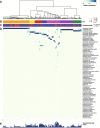Increased richness and diversity of the vaginal microbiota and spontaneous preterm birth
- PMID: 29954448
- PMCID: PMC6022438
- DOI: 10.1186/s40168-018-0502-8
Increased richness and diversity of the vaginal microbiota and spontaneous preterm birth
Abstract
Background: The bacterial community present in the female lower genital tract plays an important role in maternal and neonatal health. Imbalances in this microbiota have been associated with negative reproductive outcomes, such as spontaneous preterm birth (sPTB), but the mechanisms underlying the association between a disturbed microbiota and sPTB remain poorly understood. An intrauterine infection ascending from the vagina is thought to be an important contributor to the onset of preterm labour. Our objective was to characterize the vaginal microbiota of pregnant women who had sPTB (n = 46) and compare to those of pregnant women who delivered at term (n = 170). Vaginal swabs were collected from women at 11-16 weeks of gestational age. Microbiota profiles were created by PCR amplification and pyrosequencing of the cpn60 universal target region.
Results: Profiles clustered into seven community state types: I (Lactobacillus crispatus dominated), II (Lactobacillus gasseri dominated), III (Lactobacillus iners dominated), IVA (Gardnerella vaginalis subgroup B or mix of species), IVC (G. vaginalis subgroup A dominated), IVD (G. vaginalis subgroup C dominated) and V (Lactobacillus jensenii dominated). The microbiota of women who experienced preterm birth (< 37 weeks gestation) had higher richness and diversity and higher Mollicutes prevalence when compared to those of women who delivered at term. The two groups did not cluster according to CST, likely because CST assignment is driven in most cases by the dominance of one particular species, overwhelming the contributions of more rare taxa. In conclusion, we did not identify a specific microbial community structure that predicts sPTB, but differences in microbiota richness, diversity and Mollicutes prevalence were observed between groups.
Conclusions: Although a causal relationship remains to be determined, our results confirm previous reports of an association between Mollicutes and sPTB and further suggest that a more diverse microbiome may be important in the pathogenesis of some cases.
Keywords: CST; Diversity; Infection; Lactobacillus; Microbiome; Mollicutes; Pregnancy; Preterm birth; Richness; Vagina.
Conflict of interest statement
Ethics approval and consent to participate
This study received ethical approval from the University of British Columbia Children’s and Women’s Research Ethics Board (Approval Number H14-01954), and Mount Sinai Hospital Research Ethics Board (Approval Number 15-0184-E). All participants provided written consent at enrolment.
Consent for publication
Not applicable.
Competing interests
The authors declare that they have no competing interests.
Publisher’s Note
Springer Nature remains neutral with regard to jurisdictional claims in published maps and institutional affiliations.
Figures



References
-
- WHO. March of Dimes. PMNCH. Save the Children . In: Born too soon: the global action report on preterm birth. Howson CP, Kinney MV, Lawn JE, editors. Geneva: World Health Organization; 2012.
-
- Blencowe H, Cousens S, Oestergaard MZ, Chou D, Moller AB, Narwal R, et al. National, regional, and worldwide estimates of preterm birth rates in the year 2010 with time trends since 1990 for selected countries: a systematic analysis and implications. Lancet. Elsevier Ltd. 2012;379:2162–2172. - PubMed
-
- Behrman RE, Butler AS. In: Preterm birth: causes, consequences, and prevention. Behrman RE, Butler AS, editors. Washington, D.C.: National Academies Press; 2007. - PubMed
-
- Fraser AM, Brockert JE, Ward RH. Association of young maternal age with adverse reproductive outcomes. N Engl J Med. 1995;332:1113–1118. - PubMed
Publication types
MeSH terms
Grants and funding
LinkOut - more resources
Full Text Sources
Other Literature Sources
Research Materials

